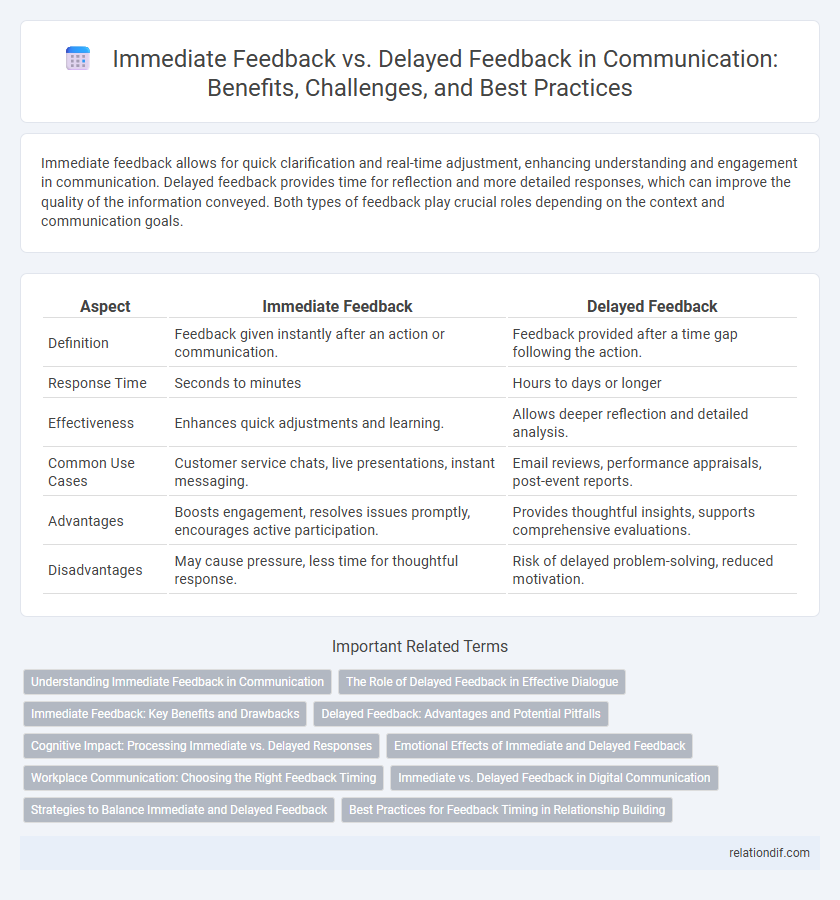Immediate feedback allows for quick clarification and real-time adjustment, enhancing understanding and engagement in communication. Delayed feedback provides time for reflection and more detailed responses, which can improve the quality of the information conveyed. Both types of feedback play crucial roles depending on the context and communication goals.
Table of Comparison
| Aspect | Immediate Feedback | Delayed Feedback |
|---|---|---|
| Definition | Feedback given instantly after an action or communication. | Feedback provided after a time gap following the action. |
| Response Time | Seconds to minutes | Hours to days or longer |
| Effectiveness | Enhances quick adjustments and learning. | Allows deeper reflection and detailed analysis. |
| Common Use Cases | Customer service chats, live presentations, instant messaging. | Email reviews, performance appraisals, post-event reports. |
| Advantages | Boosts engagement, resolves issues promptly, encourages active participation. | Provides thoughtful insights, supports comprehensive evaluations. |
| Disadvantages | May cause pressure, less time for thoughtful response. | Risk of delayed problem-solving, reduced motivation. |
Understanding Immediate Feedback in Communication
Immediate feedback in communication fosters real-time clarification, enhancing mutual understanding and reducing misunderstandings. It allows participants to quickly adjust messages based on verbal and nonverbal cues, promoting dynamic interaction. This prompt response mechanism is crucial in effective dialogue, decision-making, and conflict resolution processes.
The Role of Delayed Feedback in Effective Dialogue
Delayed feedback allows individuals time to process information fully, leading to more thoughtful and well-articulated responses in communication. This reflective approach enhances message clarity and reduces misunderstandings, especially in complex or sensitive dialogues. Incorporating delayed feedback strategically supports deeper engagement and promotes constructive, meaningful exchanges.
Immediate Feedback: Key Benefits and Drawbacks
Immediate feedback in communication enhances clarity and understanding by allowing quick correction of misunderstandings and fostering real-time engagement, which boosts motivation and learning efficiency. However, it can also cause pressure, reduce reflection time, and sometimes lead to hasty or incomplete responses, impacting the overall quality of interaction. Balancing immediate feedback's urgency with thoughtful communication is essential for effective dialogue and improved interpersonal relationships.
Delayed Feedback: Advantages and Potential Pitfalls
Delayed feedback allows individuals time to thoroughly analyze information, leading to more thoughtful and well-structured responses in communication. This type of feedback can enhance critical thinking and reduce emotional reactions, improving the quality of decision-making and problem-solving. However, delayed feedback may hinder prompt resolution and cause misunderstandings if the response lags too long or lacks context relevance.
Cognitive Impact: Processing Immediate vs. Delayed Responses
Immediate feedback enhances cognitive processing by enabling rapid correction and reinforcement, which strengthens learning pathways and improves retention. Delayed feedback allows for deeper reflection and critical thinking, promoting long-term understanding but may reduce the immediacy of error correction. Balancing immediate and delayed responses optimizes cognitive engagement by combining prompt adjustment with thoughtful analysis.
Emotional Effects of Immediate and Delayed Feedback
Immediate feedback in communication generates a sense of connection and validation, enhancing emotional engagement and motivation by addressing concerns instantly. Delayed feedback can cause anxiety, uncertainty, and decreased trust, as the emotional impact of waiting may lead to feelings of neglect or frustration. Understanding the emotional effects of feedback timing improves communication strategies, fostering stronger interpersonal relationships and better psychological outcomes.
Workplace Communication: Choosing the Right Feedback Timing
Immediate feedback in workplace communication enhances clarity and accelerates problem-solving, boosting employee engagement by addressing issues in real-time. Delayed feedback allows for thoughtful reflection and comprehensive evaluation, which can improve the quality of responses and strategic planning. Selecting the appropriate feedback timing depends on context, urgency, and the complexity of the task, ensuring optimized communication effectiveness and team productivity.
Immediate vs. Delayed Feedback in Digital Communication
Immediate feedback in digital communication enhances real-time interaction and fosters more dynamic, engaging conversations by allowing participants to quickly clarify misunderstandings and adjust their messages. Delayed feedback, common in emails and online forums, provides individuals with more time to formulate thoughtful responses but risks reducing conversational flow and increasing response ambiguity. Balancing immediate and delayed feedback mechanisms is crucial for optimizing communication effectiveness in digital platforms.
Strategies to Balance Immediate and Delayed Feedback
Effective communication strategies balance immediate and delayed feedback by leveraging real-time responses to clarify misunderstandings and enhance engagement, while using delayed feedback for thoughtful reflection and detailed analysis. Implementing structured check-ins and regular follow-ups ensures timely support without overwhelming recipients, promoting continuous improvement and deeper understanding. Prioritizing situational awareness and adapting feedback timing according to context optimizes message reception and fosters a collaborative communication environment.
Best Practices for Feedback Timing in Relationship Building
Immediate feedback enhances clarity and trust by addressing issues promptly, fostering open communication and stronger relationships. Delayed feedback allows for reflection and emotional regulation, reducing misunderstandings and promoting thoughtful responses. Balancing feedback timing according to context and individual preferences ensures effective communication and deeper connection.
Immediate feedback vs Delayed feedback Infographic

 relationdif.com
relationdif.com